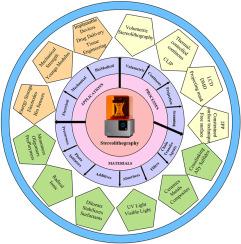基于立体光刻技术的增材制造工艺的最新进展:应用与挑战综述
Q1 Computer Science
引用次数: 0
摘要
近年来,快速成型制造工艺因其优于传统制造方法而不断进步。它们能够制造结构复杂的材料,提高精度,降低成本,为生物医学、电气、机械、航空和过滤等各种工业应用开辟了道路,并促使其不断发展。立体光刻(SLA)是一种增材制造技术,它通过光聚合反应,固化选择性树脂来制造三维物体。SLA 已成为一种领先的 3D 打印技术,为各行各业的原型设计和生产带来了革命性的变化。立体光刻技术经历了四代的发展和进步,其性能不断提高,材料更加多样化,应用领域也更加广泛。立体光刻技术实现了材料的多样化,并在优化条件下成为聚合物基复合材料的一种有前途的方法。与熔融沉积建模(FDM)等替代技术相比,SLA 具有分辨率高、光洁度高、速度快、精度高、成本低等优点。本研究旨在全面回顾 SLA 的发展及其在机械、电气和生物医学领域的工艺、应用和固有挑战。本文章由计算机程序翻译,如有差异,请以英文原文为准。

Recent advances in the development of stereolithography-based additive manufacturing processes: A review of applications and challenges
Additive manufacturing processes have progressed over recent years due to their superiority over conventional manufacturing methods. Their ability to fabricate materials with complex structures, increased precision, and reduced cost have opened avenues for various industrial applications, including biomedical, electrical, mechanical, aviation, and filtration, and led to their development over time. Stereolithography (SLA) is an additive manufacturing technique, through photopolymerization reaction, it solidifies a selective resin to produce three-dimensional objects. SLA has emerged as a leading 3D printing technique, revolutionizing prototyping and production across various industries. SLA has been through four generations of development and advancement, resulting in its improved performance, the diversity of materials, and the variety of applications. Stereolithography has diversified its material and emerged as a promising method for polymer-based composite when operating under optimized conditions. SLA offers superior resolution, high finish quality, improved speed and precision, and is cost-effective compared to alternative techniques like Fused Deposition Modeling (FDM). This current study aims to comprehensively review SLA development, its processes, applications and inherent challenges in mechanical, electrical and biomedical fields.
求助全文
通过发布文献求助,成功后即可免费获取论文全文。
去求助
来源期刊

Bioprinting
Computer Science-Computer Science Applications
CiteScore
11.50
自引率
0.00%
发文量
72
审稿时长
68 days
期刊介绍:
Bioprinting is a broad-spectrum, multidisciplinary journal that covers all aspects of 3D fabrication technology involving biological tissues, organs and cells for medical and biotechnology applications. Topics covered include nanomaterials, biomaterials, scaffolds, 3D printing technology, imaging and CAD/CAM software and hardware, post-printing bioreactor maturation, cell and biological factor patterning, biofabrication, tissue engineering and other applications of 3D bioprinting technology. Bioprinting publishes research reports describing novel results with high clinical significance in all areas of 3D bioprinting research. Bioprinting issues contain a wide variety of review and analysis articles covering topics relevant to 3D bioprinting ranging from basic biological, material and technical advances to pre-clinical and clinical applications of 3D bioprinting.
 求助内容:
求助内容: 应助结果提醒方式:
应助结果提醒方式:


